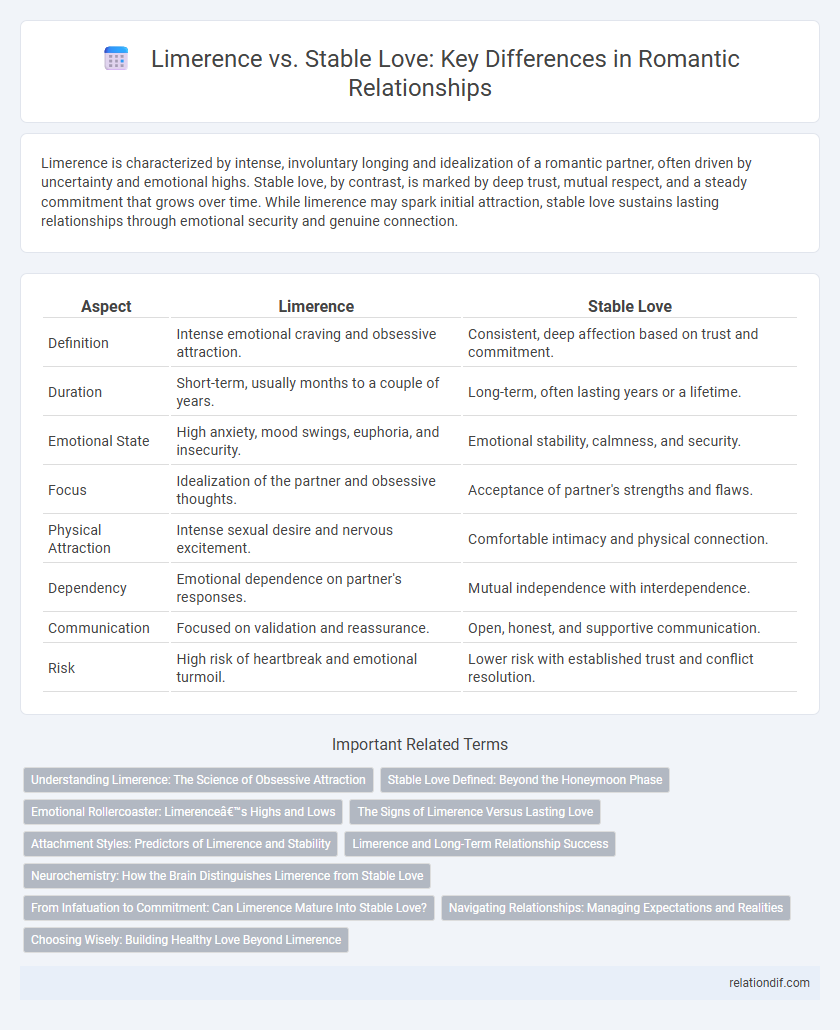Limerence is characterized by intense, involuntary longing and idealization of a romantic partner, often driven by uncertainty and emotional highs. Stable love, by contrast, is marked by deep trust, mutual respect, and a steady commitment that grows over time. While limerence may spark initial attraction, stable love sustains lasting relationships through emotional security and genuine connection.
Table of Comparison
| Aspect | Limerence | Stable Love |
|---|---|---|
| Definition | Intense emotional craving and obsessive attraction. | Consistent, deep affection based on trust and commitment. |
| Duration | Short-term, usually months to a couple of years. | Long-term, often lasting years or a lifetime. |
| Emotional State | High anxiety, mood swings, euphoria, and insecurity. | Emotional stability, calmness, and security. |
| Focus | Idealization of the partner and obsessive thoughts. | Acceptance of partner's strengths and flaws. |
| Physical Attraction | Intense sexual desire and nervous excitement. | Comfortable intimacy and physical connection. |
| Dependency | Emotional dependence on partner's responses. | Mutual independence with interdependence. |
| Communication | Focused on validation and reassurance. | Open, honest, and supportive communication. |
| Risk | High risk of heartbreak and emotional turmoil. | Lower risk with established trust and conflict resolution. |
Understanding Limerence: The Science of Obsessive Attraction
Limerence is characterized by intense, involuntary attraction driven by obsessive thoughts and emotional dependency on the beloved, often accompanied by heightened dopamine activity in the brain's reward system. Unlike stable love, which evolves through mutual trust, emotional security, and long-term attachment mediated by oxytocin and vasopressin, limerence tends to be temporary and fraught with anxiety and uncertainty. Understanding the neurochemical and psychological mechanisms behind limerence helps distinguish fleeting infatuation from enduring, stable romantic bonds.
Stable Love Defined: Beyond the Honeymoon Phase
Stable love is characterized by deep emotional connection, trust, and mutual respect that endure well beyond the initial intensity of limerence. Unlike limerence, which is fueled by obsessive longing and idealization during the honeymoon phase, stable love emphasizes commitment, realistic understanding, and consistent support between partners. This form of love fosters long-term relationship satisfaction and resilience through shared experiences and emotional intimacy.
Emotional Rollercoaster: Limerence’s Highs and Lows
Limerence is characterized by intense emotional highs and lows driven by craving reciprocation and validation, creating a turbulent rollercoaster of feelings. Stable love, in contrast, offers consistent emotional security and deep attachment grounded in trust and mutual understanding. This emotional stability fosters long-term relationship resilience and profound connection beyond initial infatuation.
The Signs of Limerence Versus Lasting Love
Intense infatuation, obsessive thoughts, and rapid mood swings characterize the signs of limerence, contrasting with stable love's deep emotional bond, mutual respect, and consistent support. Limerence often revolves around idealization and uncertainty, while lasting love embraces acceptance of flaws and dependable commitment. Recognizing these differences can help individuals navigate romantic relationships with greater clarity and emotional health.
Attachment Styles: Predictors of Limerence and Stability
Attachment styles significantly influence the experience of limerence and stable love, with anxious attachment linked to intense limerence characterized by obsessive thoughts and emotional volatility. Secure attachment predicts stable love, marked by trust, emotional regulation, and long-term commitment. Avoidant attachment often results in difficulty sustaining emotional intimacy, increasing the likelihood of unstable or short-lived romantic experiences.
Limerence and Long-Term Relationship Success
Limerence, characterized by intense longing and idealization, often ignites the initial passion in romantic relationships but lacks the emotional stability needed for long-term success. In contrast, stable love, built on trust, mutual respect, and deep emotional connection, sustains commitment and resilience over time. Research in relationship psychology reveals that couples who transition from limerence to stable love experience higher satisfaction and durability in long-term partnerships.
Neurochemistry: How the Brain Distinguishes Limerence from Stable Love
Limerence triggers intense dopamine surges linked to reward and craving, creating obsessive longing and euphoria, whereas stable love activates oxytocin and vasopressin pathways that foster attachment and trust. The brain's limbic system responds to limerence with hyperactivation of the nucleus accumbens, driving addictive behaviors, while stable love enhances prefrontal cortex activity, supporting emotional regulation and long-term bonding. Neurochemical shifts from dopamine dominance to oxytocin-mediated connectivity mark the transition from limerence to enduring romantic attachment.
From Infatuation to Commitment: Can Limerence Mature Into Stable Love?
Limerence, characterized by intense emotional longing and obsessive thoughts, often marks the early phase of romantic attraction but lacks the depth of stable love, which is built on trust, mutual respect, and long-term commitment. Neuroscientific studies suggest that as limerence decreases, the brain's reward system shifts from dopamine-driven excitement to oxytocin-facilitated bonding, signaling the potential transition to stable love. Understanding this progression helps couples navigate the shift from passionate infatuation to enduring partnership, fostering emotional resilience and relationship satisfaction.
Navigating Relationships: Managing Expectations and Realities
Limerence often involves intense emotional highs and infatuation, driven by idealized perceptions of a partner, which can obscure realistic expectations in relationships. Stable love is characterized by deep emotional security, mutual respect, and consistent support, facilitating effective communication and conflict resolution. Navigating relationships requires balancing the initial excitement of limerence with the grounded understanding of stable love to manage expectations and build lasting intimacy.
Choosing Wisely: Building Healthy Love Beyond Limerence
Limerence is characterized by intense infatuation and obsessive longing, often driven by idealization and uncertainty, while stable love is marked by deep emotional connection, trust, and mutual respect. Choosing wisely involves recognizing the fleeting nature of limerence and investing in consistent communication, emotional support, and shared values to cultivate lasting intimacy. Building healthy love requires patience and intentionality, fostering security that transcends initial passion for sustained relationship growth.
limerence vs stable love Infographic

 relationdif.com
relationdif.com